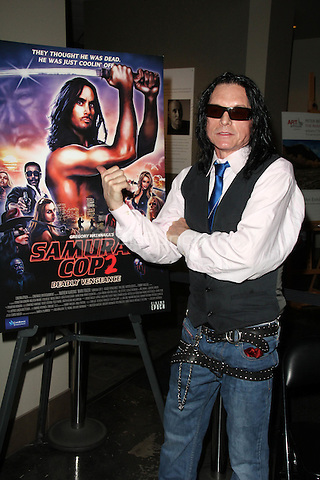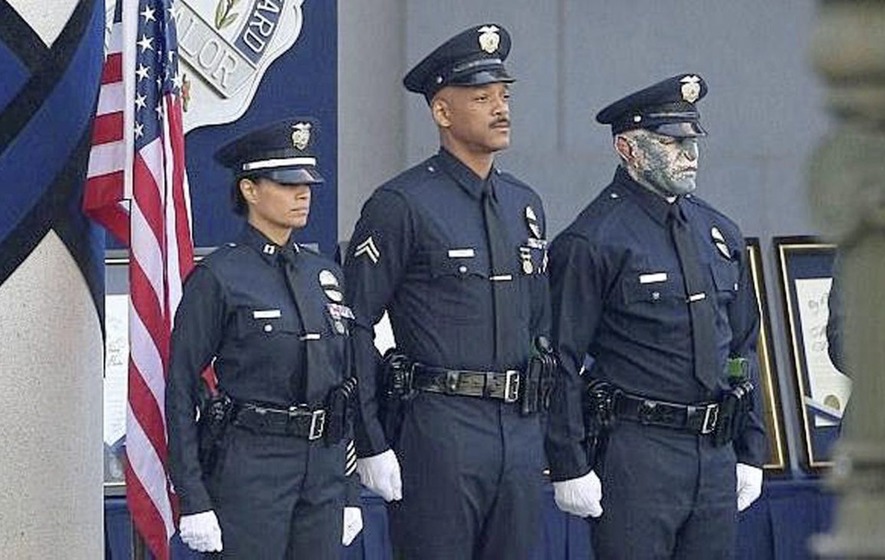Control Nathan Rabin 4.0 #18 Samurai Cop 2: Deadly Vengeance (2015)
Welcome to the latest entry in Control Nathan Rabin 4.0. It’s the column where I give you, the kind-hearted Nathan Rabin’s Happy Place patron, an opportunity to choose a film I must watch and then write about in exchange for a one time, one hundred dollar pledge to the site.
I’ve overwhelmingly written about hot garbage for this column, and, perhaps not coincidentally, for this site as well. In that respect the last two entries were anomalies, in that I was tasked with re-visiting and writing about two of the most important and talked about movies of the current century in 2004's Eternal Sunshine of the Spotless Mind and 2008's Tropic Thunder.
I return happily to the world of proud, unabashed garbage with 2015’s Samurai Cop 2: Deadly Vengeance, a Kickstarter and Indiegogo-crowd-funded sequel to the direct-to-video 1991 cult oddity Samurai Cop. The tongue-in-cheek parody of 1980s and early 1990s low-budget action garbage was a giddy trip down memory lane in more ways than one.
Samurai Cop 2: Deadly Vengeance is very deliberately a throwback to the good old days when garbage like this hit the home market in VHS boxes with impossibly lurid covers that promised more than any b-movie could ever deliver, no matter how overstuffed and crazed, rather than going direct to streaming or debuting on Amazon, Netflix or iTunes.
Watching Samurai Cop 2: Deadly Vengeance, I was thrust back in time to my wasted adolescence just barely attending high school but really throwing myself into the real, lasting education in cinematic trash I received as a clerk at Blockbuster Video. As a Blockbuster Customer Service Representative with an insatiable hunger and curiosity for low culture I was mesmerized by our store’s “Wild Action” and “Super Action” sections.
Hollywood super-producers like Joel Silver made action movies. They were respectable, big-budgeted and theatrically distributed. They might be violent or brazenly sexual but they played by the rules for the most part and intuitively understood and respected the boundary separating Hollywood entertainment from sub-Hollywood exploitation.
Dudes in the bayou in 1973 hopped up on meth and giddy with power over having control over three hundred thousand dollars of a local moonshiner’s ill-gotten loot made Wild and Super Action movies. Wild action movies were the illegitimate hillbilly cousin of action movies, the one that shows up at family gatherings drunk and spoiling for a fight.
The idea was not just to shamelessly promise exploitation movie audiences sex and drugs and naked breasts and transgressions but to promise them everything all at once. “Wild Action” was essentially “extra violent action augmented with nudity and T&A” so you could expect a busty sexpot in a wet tee shirt in front of a Confederate flag firing a powerful firearm wildly on the average VHS box. In that sense they resembled the social media avatar of the average rabid Trump super-fan today.
"Super Action", meanwhile promised manly men with rippling biceps clad in all-denim ensembles aiming machine guns at racist caricatures of Mexican drug lords or Asian soldiers, and the occasional Rudy Ray Moore vehicle. If these movies had a “star” it was inevitably somebody like Joe Don Baker, whose very name broadcast his suitability for this crazed hillbilly iteration of the action genre.
Wild and Super Action movies promised, and delivered something extra. For example, it wouldn’t be enough for a Super Action movie to center on a regular, boring old cop like an ordinary action movie might. No, they would need for that cop to also be a samurai, and for this combination cop/samurai, this “Samurai Cop”, as it were, to embark on a mission of vengeance: deadly vengeance.
In other words, in order to qualify for Wild Action or Super Action, an exploitation movie would have to be like 2015’s Samurai Cop 2: Deadly Vengeance. It’s a tongue-in-cheek bloodbath blessed with an exquisite sense of its own ridiculousness, the kind of lark that plays in the midnight section of film festivals en route to a sure-fire second life as a cult movie.
From the first frame to last, Samurai Cop 2: Deadly Vengeance is most assuredly in on the joke. That can be a problem. I’ve written extensively about Snakes on a Plane Syndrome and how nothing kills a cult movie or a camp comedy quite like an excess of winking self-awareness.
Audiences are right to be skeptical of movies that broadcast their destiny as beloved cult oddities but in the right hands winking self-consciousness can also be a tremendously winning narrative strategy. That is the case here. The filmmakers and their exceedingly game cast clearly set out to make a cult movie, a midnight movie, a movie stoned and indulgent (the two tend to go hand in hand) audiences would want to return to over and over again and because their hearts are pure, they mostly succeed.
Samurai Cop 2: Deadly Vengeance opens in 1991, the same year the original came out, with a typically meta-textual gag that relies heavily on a trash-culture-loving audience’s understanding of hoary action movie cliches. Detective Joe Marshall (Mathew Karedas) has just defeated his foes from the first film and is ready to finally settle down once and for all with girlfriend Jennifer and pump out some little Samurai cops.
Yes, they’re overcome with delusional confidence about the happy, safe and long life they’re about to lead together when of course Jennifer is unexpectedly shot and seemingly killed. A good rule of thumb for action movies like this is that the more a character talks about the deliriously happy future they’re promised, the less likely it is that they’ll see even tomorrow.
The apparent death of his soulmate has a devastating effect on Joe. He swears off violence and sets out to lead a peaceful life until a quarter century later a gang war involving deadly Asian factions forces him out of hiding and, after a quarter century absence, gets him back on the force alongside his old partner, a lady’s man whose mustachioed, cocky brand of black masculinity hasn’t been in vogue since Billy Dee Williams starred in both theatrically released motion pictures and Colt .45 advertisements in the 1980s.
Samurai Cop 2: Deadly Vengeance doesn’t just figuratively wink at the audience with its title and premise and very existence; at various points, its leads break the fourth wall and talk directly to the camera.
The IMDB entry for Samurai Cop 2: Deadly Vengeance list ten goofs like “Fuj Fujiyama is somehow alive in this movie despite visibly being shot to death in the first movie by Frank. No explanation is given as to how he survived this” and “Peggy somehow has top secret information on all the gangs despite clearly not being on the police force anymore.”
That amused me to no end because I saw the movie’s incoherence and incomprehensibility as intentional. They set out to make a movie that made very little rational sense, that was a crazy fever dream fantasy of Reagan-Bush exploitation nonsense untethered to anything resembling realism or plausibility. Not making a goddamned lick of sense is a feature of the film’s narrative strategy, not a flaw.
As part of its fierce commitment to bad film culture, the movie features a cameo from A Talking Cat!?!’s Kristine DeBell as a cop who feeds our hero relevant information and a supporting turn from Tommy Wiseau as a vengeance-crazed criminal with a dark secret linking him to our hero and his formative trauma.
A Talking Cat!?! and The Room are of course timeless, enduring anti-masterpieces of transcendently terrible trash cinema because they are gloriously, thoroughly, exceedingly un-self-aware. The makers of these eminently re-watchable fixtures of trash cinema did not set out to make crazed camp comedies overflowing with unintentional laughter and accidental comedy. It was all a beautiful, beautiful accident. That’s what made them so special.
Samurai Cop 2, on the other hand, nakedly aspires to cult glory, which could be obnoxious if it didn’t have such a strong feel for the sordid, shadowy b-movie action world of yesterday it simultaneously sends up and pays loving tribute to with over-the-top performances from the trashy likes of Bai Ling and Joe Estevez, who understandably looks and acts like his brother Martin Sheen’s Mexican non-union equivalent and is perfectly typecast as the cops’ perpetually disapproving, hectoring boss.
Bai Ling’s performance is purposefully, ironically terrible although a screamingly gratuitous strip club lesbian orgy is thrown in to give audiences something to masturbate to in a decidedly non-ironic fashion.
The performances here are deliberately terrible in a way that enhances rather than detracts from the project’s air of ebullient amateurism.
The filmmakers have created a trashy Z-movie universe where Tommy Wiseau can pop every once in a while waving around a blade and screaming at the top of his lungs or knocking things over in a destructive fit worthy of Godzilla, or, alternately, his character in The Room, and not have to worry about the deafening volume or crazed, amateur intensity of Wiseau’s performance clashing tonally with the rest of the film. That’s because everything in the movie is pitched at a Tommy Wiseau level of craziness, from the music to the editing to the exposition-crazy storytelling.
Samurai Cop 2 is no Black Dynamite, which remains the gold standard for this kind of film. Also, I have not seen the original Samurai Cop. If I had, I might see its sequel differently. If someone were to make a sequel to Miami Connection, for example, the first film I wrote about for this column and a movie I genuinely adore, and replace the original’s hypnotic, bold sincerity with smart-ass irreverence I might recoil in horror but I have no emotional investment in the Samurai Cop franchise so it did not bother me that Samurai Cop 2 took something unintentionally hilarious and made it intentionally funny.
I give Samurai Cop 2: Deadly Vengeance the official Nathan Rabin’s Happy Place seal of approval: this is quality garbage for a discriminating audience of true trash aficionados, as well as folks who just plain love the timeless combination of boobs and blood, T&A and gratuitous machine gun spray. Whether you’re in it for the winking irony and meta playfulness or to just see dudes get fucked up, Deadly Vengeance delivers.
If Blockbuster Video still existed today outside that one final store that refuses to close down, Samurai Cop 2: Deadly Vengeance would be the perfect addition to its Wild Action or Super Action sections. It’s a trashy tribute to a lost era of home video that should be available only as a VHS tape with a seriously sexed-up, hyper-violent tableau on its front cover although I suppose it’s fitting that I watched it on Youtube, because I suspect that’s where a lot of the movies that once filled Blockbuster’s exploitation-friendly sections have found their ultimate and final home now that video store chains are regrettably a thing of our past.
I make my living largely through Patreon so if you would be kind enough to nominate a film for Control Nathan Rabin 4.0 for a one-time, one hundred dollar pledge, or even donate as little as a dollar a month over at http://patreon.com/nathanrabinshappyplace it’d be









